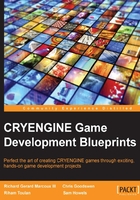
What this book covers
Chapter 1, Getting Started, shows you the CRYENGINE "Blank" Game Starter-Kit that was specifically designed to teach developers how to create a CRYENGINE game from scratch, and provide a blank slate for them to start with. You will install and compile this kit.
Chapter 2, Creating a Playable Character, shows you how to create a completely playable character from scratch and control its movement with the keyboard.
Chapter 3, Implementing Weapons and Ammo, shows you how to implement a weapon and ammo system, as the player will need a way to defeat bad guys.
Chapter 4, Creating an Enemy AI, shows you how to create an enemy AI and give it some basic intelligence.
Chapter 5, Creating User Interfaces, shows you how to create a complete start and end game menu by using Scaleform, Flash, and C++.
Chapter 6, The Modeling Workflow for Game Characters and Tools, gives an overview of the character art workflow principles, terminologies, and how to prepare for the tasks ahead.
Chapter 7, Highpoly Modeling, discusses why we need to create a highpoly model and its uses in the game in current and next-gen game development. In this chapter, we will be working with some of the principles of highpoly modeling and going through a basic workflow to create the highpoly model in Zbrush.
Chapter 8, Lowpoly Modeling, covers the lowpoly generation and some of the most important areas to remember, such as efficient topology, areas to remember for deformation, other important topics, such as an efficient UV mapping, and how to generate LODs from the original lowpoly.
Chapter 9, Texturing and Materials, explores the techniques required to create and bake textures. In this chapter, we will take a look at the tools, such as Photoshop and Zbrush, used for creating texture maps, how to bake the highpoly information to the lowpoly model by using xNormal, and also see how these baked maps can be used in the creation of textures.
Chapter 10, Building the Character Rig, shows you how to build an animator friendly rig for the character in Maya. We will also discuss the folder structure for the character files and explore the already made deformation skeleton on the character, and how to create a simple and efficient rig using that skeleton.
Chapter 11, Exporting the Character to CRYEngine, shows you how to export a character to CRYENGINE step-by-step and explains the animation pipeline and how to use Character Editor to debug and add extra secondary animations to your characters with CRYENGINE physics.
Chapter 12, Initial Level Blockout and Setup, covers the good working practices and tips used for quickly jumping into making a new level in the SDK, giving us a good base to start adding more complex scripted content later on.
Chapter 13, The Flow Graph Workflow, introduces you to the concept of Game Tokens to communicate with the Flow Graphs. We'll also cover how to set up the level logic to modularly accommodate the various scripted elements that go into making a single player level in CRYENGINE.
Chapter 14, Scripting Gameplay Content, dives deep into creating all the elements that make up a Crysis style action bubble, as we now have a solid grounding in how to efficiently and cleanly produce content for a level in CRYENGINE.
Chapter 15, Maintaining Our Work, covers testing the content or fixing the bugs that take place in the last few minutes of a half hour level, which can be a repetitive and time-wasting process.